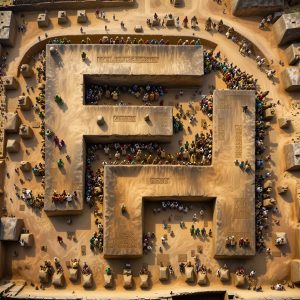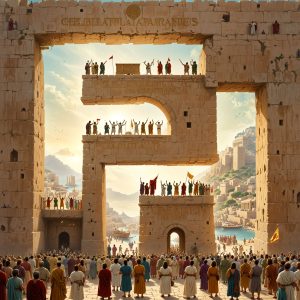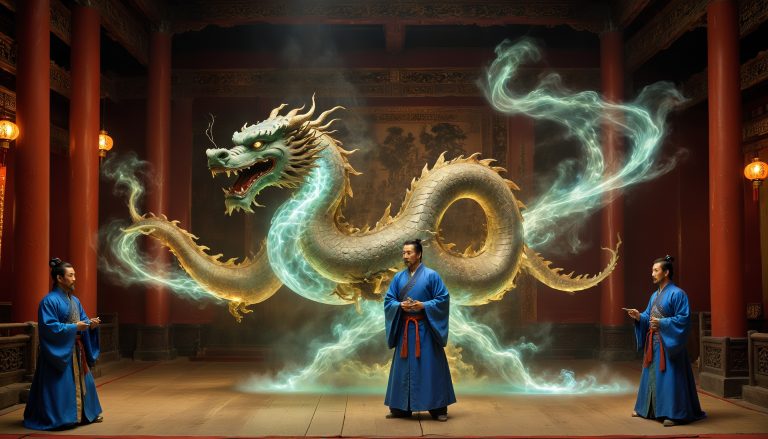FakeHistory.eu
has done it again! In an unprecedented event, the unveiling of their new logo has sparked celebrations across ancient civilizations worldwide. From the bustling marketplaces of ancient Mesopotamia to the grand temples of the Maya, the world rejoices in harmony.
The New Logo: A Timeless Masterpiece
The new logo, a blend of classic and modern elements, features an intricate design inspired by various ancient symbols. It combines the elegance of Egyptian hieroglyphs, the mysticism of Celtic knots, and the bold lines of Greek meanders, creating a timeless piece that resonates with history enthusiasts and creative minds alike.
Celebration Across Ancient Civilizations
Mesopotamia
In the heart of ancient Mesopotamia, a grand feast is underway. The ziggurats are adorned with festive banners, and the scent of roasted lamb fills the air. Priests and priestesses perform rituals, offering thanks to the gods for this momentous occasion. The local cuneiform scribes have already etched the event into clay tablets, ensuring the celebration’s legacy for future generations.
Egypt
The Egyptians have taken the celebration to new heights—literally. The Great Pyramid of Giza is illuminated with vibrant colors, casting a magical glow across the desert sands. Pharaohs and nobles gather for an extravagant banquet, while the Sphinx watches over, its enigmatic smile seemingly more pronounced in the festive light. Hieroglyphs praising FakeHistory.eu’s new logo are inscribed on temple walls, commemorating the historic moment.
Greece
In ancient Greece, the Agora is abuzz with excitement. Philosophers debate the symbolism of the new logo, while artisans display their interpretations through pottery and sculpture. The Parthenon stands proudly decorated with olive wreaths, and a grand procession winds through the streets of Athens, celebrating the unity of ancient and modern cultures.
China
Across ancient China, the unveiling has inspired a spectacular dragon dance. The Great Wall is lined with lanterns, and fireworks light up the night sky. Emperors and scholars alike marvel at the logo’s design, recognizing its harmonious blend of history and artistry. Calligraphers inscribe poems celebrating the event, while the people enjoy traditional feasts and performances.
The Maya
In the heart of the Maya civilization, astronomers align the event with celestial movements, declaring it a time of great auspiciousness. Temples are decorated with intricate carvings depicting the new logo, and the jungle echoes with the sounds of music and laughter. Offerings of cacao and maize are made to the gods, ensuring their favor and blessing.
Rome
In the Roman Empire, the celebration takes the form of a grand triumph. The streets of Rome are filled with cheering crowds as the new logo is paraded through the city. Senators and citizens alike marvel at its design, comparing it to the great works of Roman art and architecture. The Colosseum hosts games and spectacles in honor of the occasion, while poets compose verses praising FakeHistory.eu’s creative triumph.
Indus Valley
In the Indus Valley, the unveiling of the logo is marked by a harmonious festival. The great baths and marketplaces of Mohenjo-Daro and Harappa are adorned with colorful decorations. Artisans create intricate seals featuring the new logo, and the air is filled with the sounds of music and dance. The celebration reflects the Indus Valley’s renowned sense of community and artistic expression.
Persia
In the grand palaces of Persia, the celebration is a royal affair. The halls of Persepolis are filled with sumptuous feasts and elaborate ceremonies. Persian kings and nobles, known for their appreciation of art and culture, admire the new logo’s design, seeing in it a reflection of their own sophisticated tastes. Musicians play traditional instruments, and dancers perform to the delight of the gathered guests.
Phoenicia
The seafaring Phoenicians celebrate the unveiling with a maritime festival. The harbors of Tyre and Sidon are bustling with decorated ships, their sails bearing the new logo. Merchants from across the Mediterranean gather to admire the design, which resonates with their own love for intricate craftsmanship. The festival includes boat races, music, and a grand marketplace showcasing goods from distant lands.
The Hittites
In the Hittite capital of Hattusa, the celebration is a majestic gathering. The city’s grand gates and temples are adorned with symbols of the new logo, and the streets are filled with revelers. Hittite warriors, known for their prowess, join in the festivities, and the event is recorded in cuneiform on clay tablets to be remembered for generations.
Olmec
Among the Olmec civilization, known for their colossal stone heads, the new logo’s unveiling is a monumental event. Great plazas are filled with dancers and musicians, and the logo is carved into massive stone sculptures. The celebration reflects the Olmec’s deep connection to art and their legacy of impressive monuments.
Carthage
In Carthage, the celebration is a grand merchant’s gala. The city’s bustling ports are alive with activity, as traders from across the Mediterranean gather to celebrate. The new logo, seen as a symbol of cultural exchange and prosperity, is displayed on banners and coins. The festivities include banquets, performances, and a grand market showcasing the finest goods from Carthage and beyond.
Etruscan
In the cities of the ancient Etruscans, the unveiling of the new logo inspires artistic revelry. Skilled artisans and craftsmen incorporate the design into pottery, jewelry, and murals. The celebration is marked by vibrant festivals, where musicians play and dancers perform in the streets. The Etruscans, known for their rich artistic heritage, embrace the new logo as a symbol of cultural pride and innovation.
Nubian
In the Nubian Kingdom, the new logo’s unveiling is celebrated with an awe-inspiring display of lights. The pyramids and temples of Meroë are illuminated in a dazzling array of colors, casting a magical glow across the desert landscape. Nobles and citizens gather for grand feasts, with traditional music and dance performances. The new logo is seen as a bridge between the rich history of Nubia and the innovative spirit of the present.
The New Logo of FakeHistory.eu: A Symbol of Timeless Connection and Exploration
In the dynamic realm of digital storytelling, FakeHistory.eu has always stood out for its unique blend of creativity, historical depth, and imaginative narratives. The unveiling of its new logo marks a significant milestone in its journey, symbolizing a harmonious blend of the past and the present. This essay delves into the design, symbolism, and cultural resonance of this innovative logo, which also intriguingly symbolizes a maze.
Design Elements: Simplicity Meets Depth
At first glance, the new logo of FakeHistory.eu might appear as a simple arrangement of the letters “F” and “H.” However, a closer look reveals a sophisticated interplay of shapes and lines that embody the core values of the platform.
-
Geometric Precision: The logo is constructed with clean, bold lines, reflecting a sense of clarity and modernity. The geometric precision conveys a message of reliability and structure, essential for a platform dedicated to exploring historical narratives.
-
Interlocking Letters: The interlocking design of the “F” and “H” suggests interconnectedness, symbolizing the intricate weaving of historical events and stories. This design choice echoes the platform’s mission to link diverse historical threads into a cohesive narrative.
-
Timeless Monochrome: The black-and-white color scheme is both timeless and versatile. Black, symbolizing authority and elegance, paired with the stark simplicity of white, represents transparency and openness—key attributes of FakeHistory.eu.
Symbolism: Bridging Eras and Exploring Mazes
The new logo is not just a visual identifier; it is a symbol rich with meaning, bridging various eras and cultures and adding an element of exploration.
-
Ancient Influence: The stark, linear forms can be seen as a nod to ancient scripts and glyphs, such as the cuneiform writing of Mesopotamia or the hieroglyphs of Egypt. These ancient writing systems were foundational in recording human history, much like how FakeHistory.eu records and retells stories.
-
Modern Aesthetic: Simultaneously, the logo’s minimalist design aligns with contemporary aesthetic trends. This duality ensures that the logo feels both rooted in history and relevant to modern audiences.
-
Maze Symbolism: The interlocking nature of the letters “F” and “H” also evokes the image of a maze, symbolizing the complex and winding journey of exploring history. This maze-like quality invites users to navigate through the intricate pathways of historical events, discovering new connections and insights along the way.
-
Universal Connection: The maze-like interlocking letters emphasize the universal connection of human experiences. By intertwining these letters, the logo suggests that history is not isolated events but a continuous, interwoven tapestry.
Cultural Resonance: Celebrating Global Heritage
FakeHistory.eu’s logo resonates with a global audience, celebrating the rich tapestry of human heritage and the adventure of historical exploration.
-
Mesopotamian Echoes: The linear and angular elements of the logo can evoke the early forms of written language, paying homage to the cradle of civilization where storytelling began.
-
Egyptian Hieroglyphs: The bold, graphic style of the logo can remind viewers of the iconic and highly stylized nature of Egyptian hieroglyphs, which were used to tell stories of gods and pharaohs.
-
Greek Meanders: The interlocking pattern is reminiscent of Greek meander patterns, symbolizing infinity and unity, much like the endless stories and interconnected histories explored on FakeHistory.eu.
-
Modern Minimalism: The simplicity and clarity of the logo also align with modern minimalist design principles, ensuring that it appeals to contemporary sensibilities while celebrating historical aesthetics.
-
Labyrinthine Quality: The maze-like design has cultural resonance with various civilizations that used labyrinths and mazes as symbols of journey and discovery, such as the Greek myth of the Minotaur in the labyrinth or the intricate city layouts of ancient civilizations.
A Celebration of Storytelling and Exploration
The new logo of FakeHistory.eu is more than just a visual mark; it is a celebration of storytelling and exploration. It embodies the platform’s mission to explore and narrate the vast, interconnected stories of human history.
-
Visual Identity: As a visual identity, the logo provides a strong and recognizable symbol that users can associate with quality, creativity, and historical depth.
-
Narrative Inspiration: The design itself can serve as an inspiration for new stories and explorations, encouraging users to see the connections between past and present, and to appreciate the rich tapestry of history.
-
Cultural Celebration: By incorporating elements that resonate with various ancient civilizations, the logo celebrates global cultural heritage, inviting a diverse audience to engage with and contribute to the platform.
-
Journey of Discovery: The maze-like quality of the logo invites users to embark on a journey of discovery, navigating through the complex and fascinating pathways of history, much like navigating a labyrinth.
Conclusion: A Timeless Mark for a Timeless Mission
The new logo of FakeHistory.eu is a masterful blend of simplicity and depth, modernity and antiquity, and exploration. It serves as a fitting symbol for a platform dedicated to the exploration and celebration of history’s endless narratives. Through its design, symbolism, and cultural resonance, the logo not only represents FakeHistory.eu’s mission but also inspires a deeper appreciation for the rich, interconnected stories that define human history and the adventurous spirit of exploring these narratives.
Actual Knowledge:
-
Mesopotamian Feasts: Feasts in ancient Mesopotamia often involved elaborate rituals and offerings to gods and goddesses, reflecting the civilization’s rich religious traditions source.
-
Illuminations in Egypt: While there is no historical record of the Great Pyramid being illuminated in ancient times, modern light shows have become a popular way to celebrate Egypt’s heritage source.
-
The Agora in Greece: The Agora of ancient Athens was a central public space used for assemblies, markets, and debates, highlighting its importance in Greek social and political life source.
-
Dragon Dances in China: The dragon dance is a traditional Chinese performance often seen during celebrations, symbolizing power, strength, and good luck source.
-
Maya Astronomy: The Maya were known for their advanced understanding of astronomy, often aligning their architectural structures with celestial events source.
-
Roman Triumphs: Triumphs were grand parades held in ancient Rome to celebrate military victories, often involving elaborate displays and public festivities source.
-
Indus Valley Seals: The Indus Valley civilization is known for its intricate seals, used for trade and administrative purposes, often featuring animal motifs and inscriptions source.
-
Persian Celebrations: The Persian Empire was known for its grand feasts and celebrations, often held in the opulent palaces of Persepolis source.
-
Phoenician Maritime Culture: The Phoenicians were renowned seafarers and traders, with a rich maritime culture that included shipbuilding and navigation source.
-
Hittite Warriors: The Hittites were known for their military prowess and use of chariots, often depicted in their art and recorded in their texts source.
-
Olmec Colossal Heads: The Olmec civilization is famous for its colossal stone head sculptures, representing rulers and significant figures source.
-
Carthaginian Trade: Carthage was a major center of trade and commerce in the ancient Mediterranean, known for its strategic ports and thriving markets source.



















